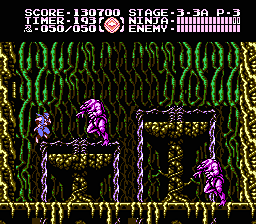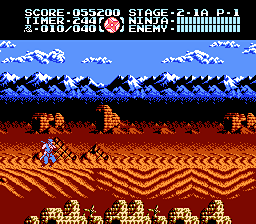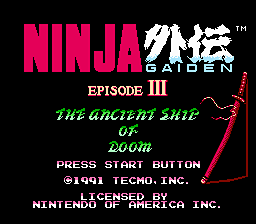
Ninja Gaiden III: The Ancient Ship of Doom (1991-)
Developer: Tecmo
Publisher: Tecmo
Genre: Platform
Ninja Gaiden III: The Ancient Ship of Doom for the NES was developed and published by Tecmo and released in 1991. It is the third installment in the Ninja Gaiden series, following Ninja Gaiden II: The Dark Sword of Chaos, and continues the story of Ryu Hayabusa as he battles a new, mysterious threat to the world. Inspired by ninja films, Japanese folklore, and action-adventure games, the title sought to maintain the cinematic storytelling and fast-paced platforming that defined the series, while introducing new gameplay mechanics and more complex level designs.
The game’s story centers on Ryu’s mission to uncover the truth behind a secretive organization responsible for a series of terrorist attacks and supernatural occurrences. Players traverse a variety of locations, including urban streets, laboratories, and ancient temples, encountering new enemies, traps, and environmental hazards. As with the previous games, cutscenes are used to advance the narrative between levels, keeping players engaged in the unfolding drama while emphasizing Ryu’s role as a heroic ninja protagonist.
Gameplay in Ninja Gaiden III retains the series’ side-scrolling platform mechanics but introduces stricter timing requirements and more challenging enemies. Ryu can attack with his sword, throw ninja stars, and climb walls to navigate obstacles, while a new feature adjusts his stamina, making precision and careful management of resources essential. The game’s soundtrack provides intense and fast-paced compositions that complement the high-pressure action, while sound effects accentuate combat, jumps, and environmental hazards. These audio elements combine to reinforce the urgency and danger of Ryu’s quest.
While Ninja Gaiden III did not have a direct NES sequel, it remains the final installment of the original NES trilogy. The game was promoted through video game magazines and print advertisements highlighting its cinematic cutscenes, challenging platforming, and ninja combat. Reception at the time was mixed to positive; critics praised the game’s graphics, narrative, and faithful continuation of the series, but noted its steep difficulty and occasional control frustrations. Despite these challenges, it is remembered as a significant entry in the NES action platformer library and a fitting conclusion to Ryu Hayabusa’s early adventures.
Images from MobyGames
Buy Ninja Gaiden III: The Ancient Ship of Doom
Click one of the Ebay or Amazon buttons below to check the latest prices and purchase Ninja Gaiden III: The Ancient Ship of Doom for the Nintendo Entertainment System.

Related Searches
Ninja Gaiden III: The Ancient Ship of Doom NES Download
Ninja Gaiden III: The Ancient Ship of Doom is available to purchase and download from a range of vendors. Always shop around...
Ninja Gaiden III: The Ancient Ship of Doom NES Manual
Various repositories around the internet have scanned and archived a range of retro manuals. Search now to.....
Ninja Gaiden III: The Ancient Ship of Doom NES Rom
We don't host or link to rom sites for this game. However, there are many sites out there that may be...
Ninja Gaiden III: The Ancient Ship of Doom NES Walkthrough
Many sites - particularly YouTube - host a range of walkthrough videos to guide you in your quest to get...
Ninja Gaiden III: The Ancient Ship of Doom NES Cheats
There are various sites out there that can offer cheat codes for games. Search now to find all available...
Ninja Gaiden III: The Ancient Ship of Doom NES Controls
This information can often be obtained through the user manual. Alternatively there are many sites out there...
Ninja Gaiden III: The Ancient Ship of Doom NES Release Date
The initial release date for Ninja Gaiden III: The Ancient Ship of Doom is stated as August 1991. Other ports of the game may..
Ninja Gaiden III: The Ancient Ship of Doom NES Review
There are many sites out there that have collated and documented historic reviews of this game. Search now...
Ninja Gaiden III: The Ancient Ship of Doom Famicom
As a Nintendo Entertainment System release, this game was also likely also available on the Famicom. This....
Ninja Gaiden III: The Ancient Ship of Doom NES Speedrun
There is now a community of competitive speedrunners who will try and gain the fastest possible time on their....








